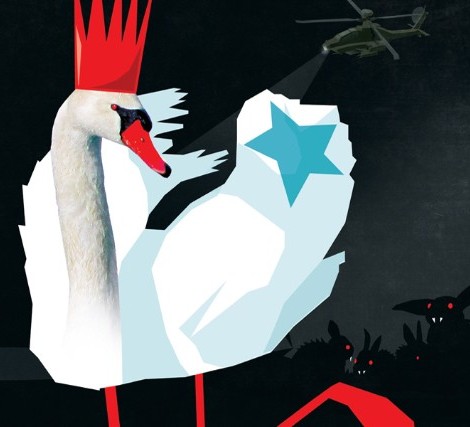Black Fairytale: both pain and inspiration
12/8/2012
Yossi Berg and Oded Graf seek to investigate the concept of Utopia in a thought-provoking work, without giving up any physical or creative richness
A group of dancers surround one dancer, who throws countless questions at them. To each of them the answer is “Yes”, even if this means a contradiction, or agreeing with a stupid, meaningless statement. The automatic “Yes” reflects something in the cultural and political climate of the present. The consent to accept the existing situation, even when it is clear that the leaders responsible for it are doing harm, has become one of Israel’s main characteristics. But will the promise of a better future that the new leaders are trying to offer manage to undermine this mechanism? In “Black Fairytale”, Yossi Berg and Oded Graf seek to investigate the concept of Utopia, or more precisely, its presence and its effect on our lives. This concept, which has been rolling around in Western thought for thousands of years, has two meanings – “the best place” and “nowhere”. But even though Utopia is inaccessible and to a large extent impossible, it is still a fantasy that represents what is good, worthy. In other words, sketching Utopia means to outline the ideal society, in which everyone acts according to the proper moral precepts.
This concept appears to involve a dichotomous separation between good and evil, between what is and what should be, and it almost always calls for a radical change and an overthrow of the existing order. Berg and Graf present a web of movement that actually emphasizes the proximity between reality and dream, like the flashing of a dynamo light, which is alternately switched on and off by movement itself. In the first scene, the dancers stretch their limbs, as if they are being pulled from outside in different directions. But in the same scene they also hit and strike themselves, not necessarily as an act of punishment, but as a means of assembly and defense against the other. At the start of the work the whole ensemble sing a sugary pop song, whose words joyfully call on us to continue on our way and to be strong. Its most prominent word – “love” – is repeated like a mantra even when the music ends, and its material dimension twinkles and breaks through the meaning, so that it sounds both like “love” and also like the Hebrew word “lahav” (flame). The phonetic similarity is also part of the flashing light that Berg and Graf point towards a world in which grief and joy appear by turns.
As in “Animal Lost”, so too in “Black Fairytale”, words are used copiously on the stage. One dancer relates what might be a nightmare or a childhood memory, about a visit to the Western Wall. What begins as a fairytale quickly turns into a nightmare, which sometimes sounds like a Freudian case study. The dancer tells it all into a microphone held by another dancer, who continuously moves and changes his position. The range of literary genres is thus joined by confession, as a religious practice but also as a television frame that is familiar from reality shows. Sometimes the use of words in a dance performance comes at the expense of the choreography, but in this case it supported and strengthened it. The reason is that like every gesture, duet and lighting cue, the words here have also been considered precisely and meticulously. At the same time, this is not a cold, intellectual work that uses the stage like a political megaphone.
Unusual nudity
In the second part of the performance, Berg and Graf have chosen to undress the male and female dancers, leaving them wearing only black briefs. The use of nudity sweeps everyone into a dance in which that same flashing returns – this time between softness and darkness. Since the nudity of female dancers is less “routine” than that of male dancers, an interesting esthetic experience is created. The play between nudity, which is an erotic presentation in every way, and the creation of a uniform appearance of all the bodies on the stage, manages to hold both these meanings without relinquishing either one of them. The sexual illuminates the asexual, the refined illuminates the impure, and so on.
“Black Fairytale” does not strike the viewer with one hard blow to the gut, but slowly and gradually injects into the body a thick liquid that combines both pain and inspiration. The ending, with Ravel’s famous Bolero, was an epic war scene, where it is not clear whether the soldiers are returning from battle or once again departing for battle. The primary dichotomy between good and evil with which they started out shows the fragility of the two extremes and above all, that each interprets and gives meaning to the other. This is a thought-provoking work that does not give up any physical or creative richness.
– Tal Levin, Achbar Online

Photo robin Hart